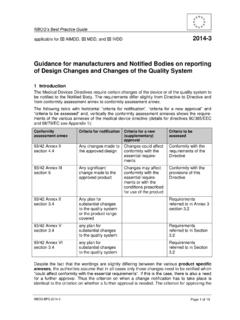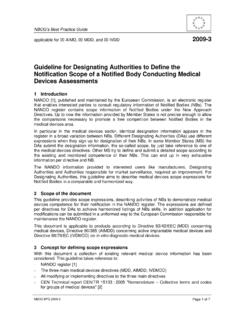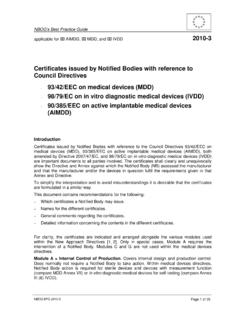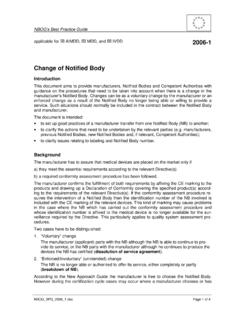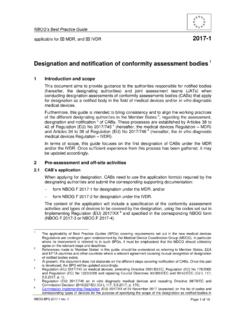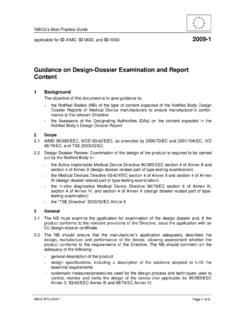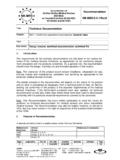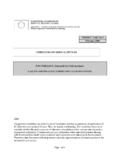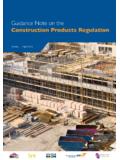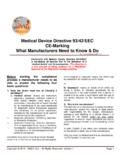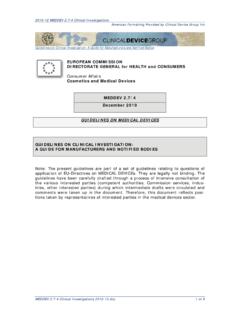Transcription of Guidance on Notified Body‘s Tasks of Technical ...
1 NBOG's Best Practice Guide applicable for AIMDD, MDD, and IVDD 2009-4. Guidance on Notified Body s Tasks of Technical documentation assessment on a Representative Basis 1 Introduction The Directive 93/42/EEC concerning medical devices (MDD) contains possible conformity assessment procedures in order to CE mark devices. Up to now, there has been inconsistency in the way Notified Bodies (NB) have performed the assessment of Technical documentations for Class lla and Class llb products following quality system conformity assessment routes. The Directive 2007/47/EC, covering the revision of the MDD, includes additional requirements for review of Technical documentation for all Class IIa and Class IIb medical devices covered by quality system assessment routes.
2 2 Scope This guideline has been prepared for NBs on how to assess the Technical documentation on a representative basis according to the Directive 2007/47/EC. Attention was given to the sampling size and depth of the assessment . It will also be useful for Designating Authorities in monitoring the performance of their NBs in this area. 3 Definitions Device subcategory (Directive 2007/47/EC, Art. 2, Paragraph 1 (iii), point (l) and Directive 93/42 EEC Art 1 Paragraph 2 (l)). A set of devices having common areas of intended use or common technology. Generic device group (Directive 2007/47/EC, Art.)
3 2, Paragraph 1 (iii), point (m) and Directive 93/42 Art. 1 Paragraph 2 (m)). A set of devices having the same or similar intended uses or commonality of technology allow- ing them to be classified in a generic manner not reflecting specific characteristics. 4 Directive Requirements Class IIa devices For Class IIa devices the requirements are covered in Directive 2007/47/EC at Annex ll, Para- graph 2 (i), Paragraph 5 (f), and Paragraph 6 (e). The Directive 93/42/EEC is amended and An- nex II , Annex V and Annex VI , states that For devices in Class IIa the Notified body shall assess.
4 The Technical documentation for at least one representative sample for each device subcategory for compliance with the provisions of this Directive.. NBOG BPG 2009-4 Page 1 of 5. NBOG's Best Practice Guide 2009-4. Class IIb devices For Class IIb devices the requirements are covered in Directive 2007/47/EC at Annex ll, Para- graph 2 (i). The Directive 93/42/EEC is amended and Annex II states that For devices in Class IIb the Notified body shall assess, as part of the assessment in Section , the Technical documentation as described in Section (c) for at least one representative sample for each generic device group for compliance with the provisions of this Directive.
5 Concept of the reviews Directive 2007/47/EC, Recital (22) introduces the concept of the reviews of Class lla and llb de- vices: The depth and extent of this review should be commensurate with the classification of the device, the novelty of the intended treatment, the degree of intervention, the novelty of the technology or construction materials, and the complexity of the design and/or technology. This review can be achieved by taking a representative example of design documentation of one or more type(s) of devices from those being manufactured. Further review(s), and in particular the assessment of changes to the design that could affect conformity with the essential require- ments, should be part of the surveillance activities of the Notified body.
6 Directive 93/42/EEC is amended and in Annex II , Annex V and Annex VI , there are rationales provided for the sampling: In choosing representative sample(s) the Notified body shall take into account the novelty of the technology, similarities in design, technology, manu- facturing and sterilisation methods, the intended use and the results of any previous relevant assessments ( with regard to physical, chemical or biological properties) that have been carried out in accordance with this Directive. The Notified body shall document and keep avail- able to the competent authority its rationale for the sample(s) taken.
7 Requirements for surveillance assessments Directive 2007/47/EC Annex ll, Paragraph 2 (i), Paragraph 5 (f), Paragraph 6 (e) and Para- graph introduces requirements for surveillance assessments. The Directive 93/42/EEC is amended and in Annex II , Annex V and Annex VI it is stated: Further samples shall be assessed by the Notified body as part of the surveillance . 5 Timing Directive 2007/47/EC Article 4 states Member States shall apply those measures from 21. March 2010 . Following the adoption of Directive 2007/47/EC, from 21 March 2010 at the latest, for Class IIb devices following the Annex II assessment route and Class IIa devices following the Annex II, V.
8 Or VI assessment route there is a specific requirement for Technical documentation to be reviewed by the NB on a sample basis. At any rate and at the latest, the first surveillance fol- lowing 21 March 2010 will need to address this element. After the 21 March 2010 new certificates can be issued only according to the new requirements. For existing certificates issued prior to this date please see Interpretative document of the Commission's services Implementation of Directive 2007/47/EC amending Directives 90/385/EEC, 93/42/EEC and 98/8/EC [1] for details. In this document the Commission's ser- vices call upon the member states to require Notified Bodies to ensure that surveillance audits are performed at least once a year as specified in the standard EN ISO /IEC 17021 [2].
9 NBOG BPG 2009-4 Page 2 of 5. NBOG's Best Practice Guide 2009-4. 6 Depth of assessment The assessment of each set of Technical documentation selected, as a minimum, should con- sist of a review of the intended use including confirmation that the product is a medical device and it's correct classification, the validity of the essential requirements checklist, especially when harmonized standards have not been applied in full, risk management file, pre-clinical data (studies in animal models, biocompatibility, Technical performance tests etc.), clinical evaluation in accordance with 93/42/EEC Annex X (Note the NB review should be as per MEDDEV [3]), information supplied by the manufacturer (label, instructions for use), declaration of conformity or the draft thereof, other Technical documentation based on risk, and should be done according to the respective parts of NBOG BPG 2009-1 [4].
10 Consequently, there will be one part of the assessment performed within the normal course of the audit but in addition, file reviews will be necessary. The time spent on the review and the level of expertise used should be proportionate to the risk and complexity of the devices in question. For the more complex devices this may require a detailed Technical review. If such an in depth assessment is not considered necessary then a justification should be available. Depending on the risk and complexity of the device(s), different experts may be involved. Therefore, NBs may not be able to perform the complete assessment on site.
